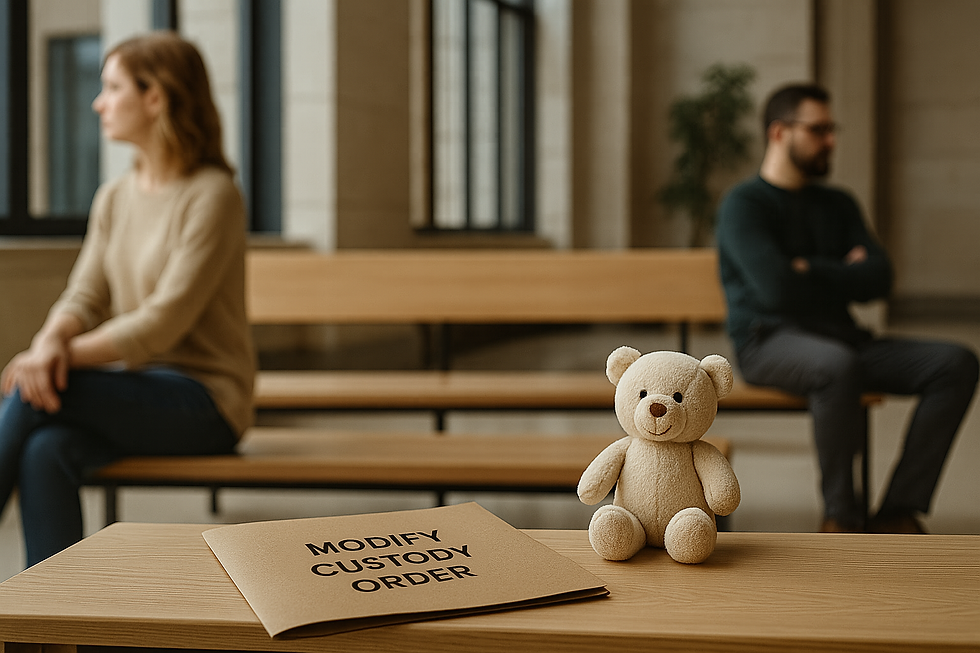What Is the Custody Process Like in North Dakota?
- Heartland

- Aug 1
- 4 min read

If you’re navigating a separation, divorce, or a breakup involving children, you might be wondering: What is the custody process like in North Dakota? This guide breaks down each step—from filing the initial paperwork to attending court—so you know what to expect and how to prepare.
Whether you’re in Bismarck, Minot, Williston, or a rural North Dakota town, the custody process follows the same legal framework set by state law. But how it unfolds can depend heavily on your unique situation and how cooperative both parents are.
Understanding Custody in North Dakota
Before diving into the process, let’s clarify what “custody” means in North Dakota. The legal term is “parenting rights and responsibilities” under North Dakota Century Code § 14-09-00.1.
There are two main types:
Legal custody (decision-making authority): Who makes major decisions about the child’s health, education, and welfare.
Physical custody (residential responsibility): Where the child lives and which parent provides daily care.
North Dakota generally encourages shared parenting, but it depends on the child’s best interests.
Step-by-Step: The Custody Process in North Dakota
Step 1: Filing for Custody
To begin the custody process in North Dakota, one parent must file a petition for custody or parenting time. This typically happens in the context of:
A divorce case (if married)
A custody action (if unmarried)
A motion to modify custody (if an existing order is in place)
Where to file: The district court in the county where the child resides, such as Burleigh County (Bismarck), Ward County (Minot), or Cass County (Fargo).
Tip: Forms are available through the ND Legal Self Help Center, but legal guidance is strongly recommended for contested cases.

Step 2: Serving the Other Parent
After filing, the other parent must be legally served with the custody paperwork. This gives them the opportunity to respond and participate in the process.
Step 3: Temporary Orders (Optional)
If immediate arrangements are needed—such as who the child lives with or how bills are paid during the case—either party can request a temporary order hearing. This order stays in effect until a final custody decision is made.
Step 4: Parenting Investigations & Mediation
North Dakota courts may require:
Mediation: An attempt to resolve disputes before trial.
Parenting Investigator: A neutral third party who investigates and recommends a custody arrangement based on the child’s best interests.
Courts look at factors under N.D.C.C. § 14-09-06.2, including:
Emotional ties between parent and child
Stability of each home environment
Ability to meet the child’s needs
Any history of domestic violence
Step 5: Parenting Plans
Each parent may be asked to submit a proposed parenting plan outlining:
Physical custody schedules
Holidays and vacations
Decision-making authority
Communication expectations
If both parties agree, the plan can be adopted by the court. If not, the court will decide after a hearing or trial.
Step 6: Custody Trial (If Necessary)
If parents cannot agree on a custody arrangement, the case proceeds to a custody trial before a district court judge. Both sides present evidence and testimony, and the judge issues a final custody order based on the child’s best interests.
Step 7: Final Custody Order
Once the judge makes a decision, a final judgment is entered. This becomes the enforceable custody order.
Parents must follow this order unless it is later modified by the court due to a significant change in circumstances (such as relocation, endangerment, or one parent failing to follow the plan).
FAQs About the Custody Process in North Dakota:
Can custody be changed after the order is in place?
Yes. North Dakota allows modifications after two years if there’s a material change in circumstances. However, changes sooner than two years require a showing of danger or harm to the child.
What if a parent violates the custody order?
You can file a motion for contempt with the court. Judges take enforcement seriously and may impose fines or even jail time for repeated violations.
Do grandparents have custody or visitation rights?
In limited cases, yes. Grandparents can petition for visitation under certain conditions, especially if it serves the child’s best interests.
How Long Does the Custody Process Take?
It depends. Some cases resolve in a few months with cooperation and mediation. Contested cases—especially those involving evaluations or trials—can take a year or more. The timeline often depends on:
Complexity of the dispute
Availability of court dates
How willing each party is to settle

Tips for Navigating Custody in North Dakota:
Stay child-focused: Judges care most about what benefits the child—not what’s fair to the parents.
Document everything: Keep records of communication, parenting time, and any concerns.
Avoid retaliation: Don’t withhold parenting time, badmouth the other parent, or involve children in legal conflict.
Work with an attorney: Especially if custody is contested or involves allegations of abuse, neglect, or relocation.
We Help Parents Across North Dakota Protect Their Rights
At Heartland Law Office, we understand how stressful custody disputes can be. Whether you're filing for the first time or seeking a change in an existing order, we help parents across North Dakota—from Bismarck to Bottineau—navigate the custody process with clarity and confidence.
Ready to take the next step? Schedule a consultation or call 701-JUSTICE today.
Check out our Family Law page and other related blogs:
Disclaimer:This article is for informational purposes only and does not constitute legal advice. Always consult with a licensed attorney regarding your specific situation.





Comments